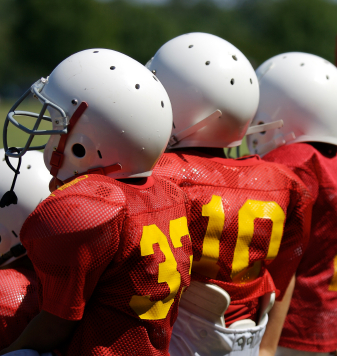Here are the facts about what causes a sports concussion:
- No direct blow to head required: A concussion may result from a direct
blow to the head, face, neck, or elsewhere on the body where the
force of the blow is transmitted to the head. Recent studies of college football players have shown that
concussions occur from blows to different parts of the head and of
varying magnitude. There is therefore no way to know for certain whether
a particular blow will lead to a concussion.

- Direct blow to head more likely to cause concussion: The forces generated by a direct blow to the head (see kinds of forces below) are about fifty times greater than forces transmitted to the head from being struck on another part of the body, and tend to be the most damaging.1
- No particular force of blow required: A relatively minor impact may result in a concussion while a high-magnitude hit to the head may not. Concussions from relatively minor impact are more likely in athletes with a multiple concussion history, or where their brains have not yet healed from a previous concussion.
- Two kinds of forces cause concussion: Concussions result from two different kinds of accelerations or forces: linear and rotational:
- Linear forces are straight-ahead forces, snapping the player's head violently backward or forward at the moment of impact.
- Rotational forces are hits to the side of a player's head or body, violently whipping the player's head to one side.
- High school players suffer more intense impacts: A recent study2 suggests that high school football players, especially those playing the so-called "skill" positions (i.e. quarterback, running back, wide receiver) suffer more intense impacts to their heads than their college counterparts, and hence are more susceptible to concussion and severe spinal injury.
- Rotational forces likely more injurious. While both linear and rotational forces are involved in almost every hit to the head, researchers and other experts believe that rotational forces are more injurious.1
- Even younger players are hit hard enough to cause concussion: The data suggests that youth football players as young as 6 years-old get hit almost as hard, although not nearly as often, as older players, according to a surprising 2012 study.3
- Top-of-the-head impacts more likely to cause concussion: Impacts to the top of the head (such as occur in helmet-to-helmet contact) tend, however, to be higher in magnitude and appear to be more likely to cause concussion. Teaching proper tackling technique (keeping head up) and avoiding contact to the top of the helmet is therefore critically important.
For the most comprehensive, up-to-date concussion information on the Internet, click here.
1. Cantu, R. Concussions and Our Kids (2012 Houghton Mifflen Harcourt) at p. 5.
2. Broglio, et. al, Head Impacts During High School Football: A Biomechanical Assessment, J Athletic Tr. 2009; 44(4): 342-349.3. Daniel R, Rowson S, Duma S. Head Impact Exposure in Youth Football. Annals of Biomed Eng 2012: DOI:10.1007/s10439-012-0530-7 (accessed February 15, 2012).
Updated September 11, 2012








